NRAO eNews
Volume Vol#, Issue Iss#
Day# Month# Year#
NRAO eNews
Volume Vol#, Issue Iss# • Day# Month# Year#

Upcoming Events

Special Session: ALMA Status and Plans for Increased Capability
Jan 9, 2023 | Seattle, WA

ngVLA Special Session: Chemical Probes of Astrophysical Systems
Jan 10, 2023 | Seattle, WA

NRAO Town Hall
Jan 11, 2023 | Seattle, WA

Splinter Session: The NRAO Science Ready Data Products Initiative and Using the VLA Sky Survey
Date TBD | Seattle, WA

19th Synthesis Imaging Workshop
Jun 13 - 21, 2023 | Charlottesville, VA
VLASS Single Epoch Continuum imaging
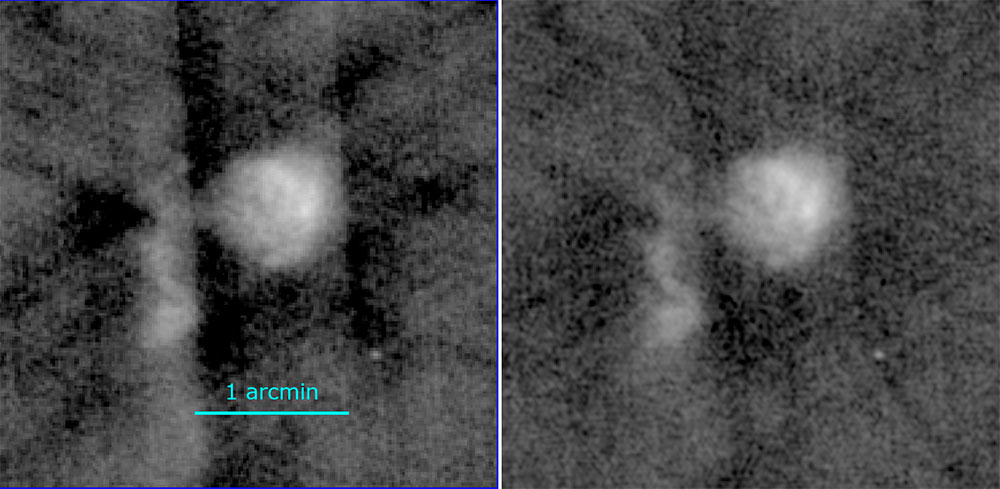
VLASS2.1 images of an HII region in Cygnus showing the improvement from Quick Look (left) to Single Epoch (right). The greyscale settings of both images are identical. The better cleaning of extended structure in the Single Epoch image is clearly visible.
[click to enlarge]
The first 1130 Single Epoch Continuum Images (SECI) are now available from the VLASS website. The SECI are higher quality versions of the Quick Look (QL) images that are already available. Self calibration is used to improve the phase calibration, resulting in about a factor of two improvement in the dynamic range near bright sources compared to QL. Self calibration also allows the images to be cleaned more deeply. The images have a finer pixel scale (0.6”/pixel) than QL that improves the sampling of the point spread function. In-band spectral indices are also available, both in the form of pre-calculated and masked spectral index images, and also as first Taylor Term (tt1) images that, when divided by the zeroth Taylor Term images (tt0), form a spectral index image that users can mask at their preferred level. The in-band spectral indices have limitations on their accuracy, and users of the spectral indices should be sure to read the users guide before using the spectral indices for science. We are beginning SECI production with data from the VLASS2.1 campaign. Further SECI images will be produced over the coming months as resources permit.
19th Synthesis Imaging Workshop, Charlottesville: Save the Dates!

The 19th NRAO Synthesis Imaging Workshop will be held 13-21 June 2023 in Charlottesville, Virginia. The workshop will consist of lectures on aperture synthesis theory and techniques at a level appropriate for graduate students in astrophysics. The program will include discussion groups, and tutorials demonstrating data collection, calibration, and imaging of various types of observations, including new data from the Very Large Array (VLA), Very Long Baseline Array (VLBA), Atacama Large Millimeter/submillimeter Array (ALMA), and Long Wavelength Array (LWA).
Pre-Registration is now open! Let us know you are interested in attending. This workshop will be limited in capacity and it fills every year. Pre-registration will ensure that you are the first to know when registration opens and that you receive all updates and information. Any questions, comments or concerns, please contact the meeting organizers.
ngVLA Project News
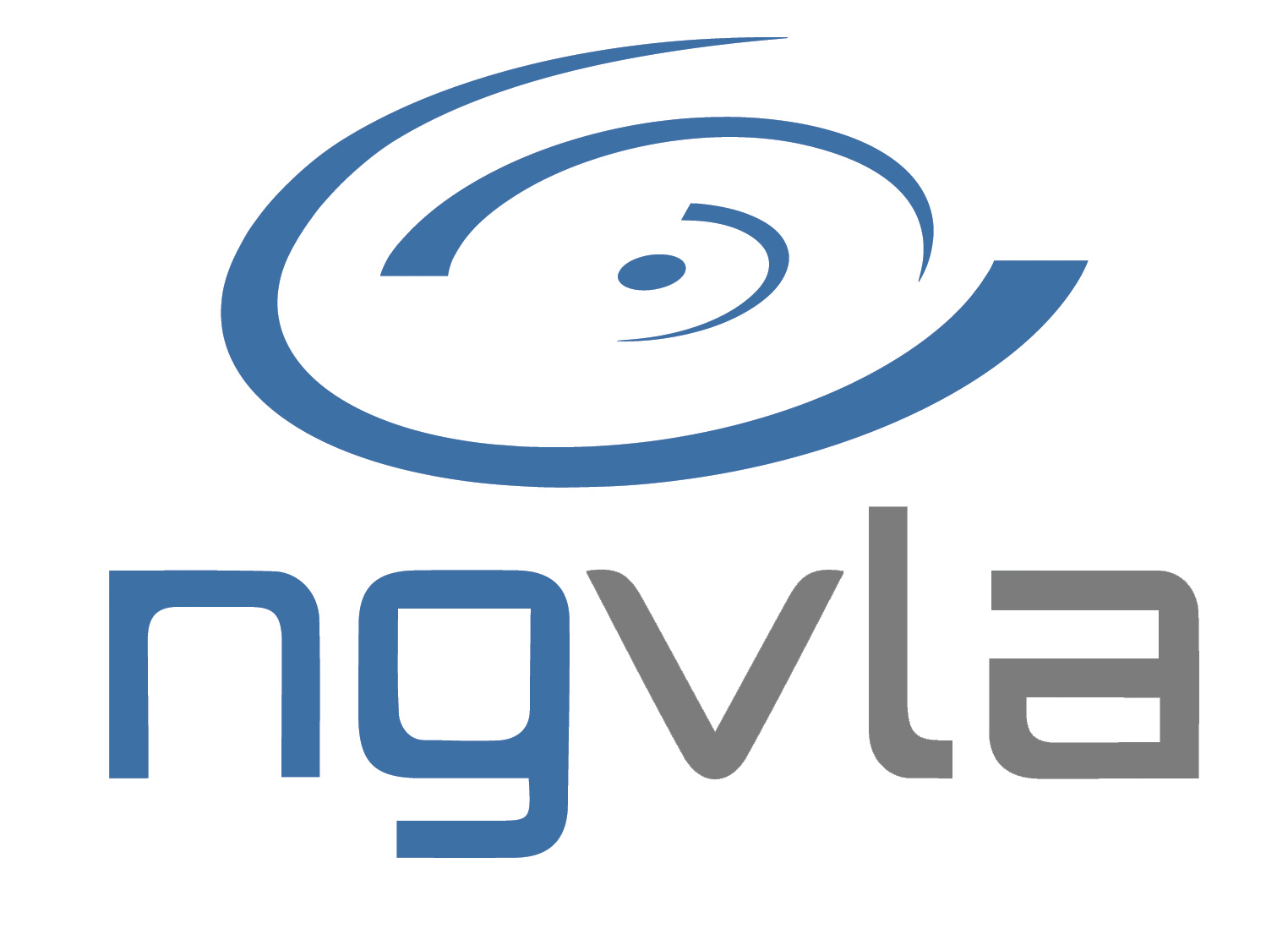
Science Working Groups Restructured
The ngVLA Science Working Groups (SWGs) were restructured to better align their topics with the science priorities identified by the Astro2020 Decadal Survey. We
are pleased to announce the SWG topics and new co-chairs:
Stars, Planetary Systems, and Their Origins
- (Proto-)planetary systems and formation; cloud cores to stars; Solar System; SETI
- Brenda Matthews (NRC-Victoria) & David Wilner (Harvard CfA)
Astrochemistry and the Molecular Emergence of Life
- Molecular astrochemistry; prebiotic molecules; star and planet-forming regions
- Brett McGuire (MIT) & Jennifer Bergner (Chicago)
Galaxies and Galaxy Evolution
- Galaxies at all redshifts; cool gas and dust; dynamics; active galactic nuclei and supermassive black holes
- Fabian Walter (MPIA) & Rachel Somerville (Flatiron Institute/CCA)
Pulsars, Cosmology, and Fundamental Physics
- Tests of gravity; relativity and stellar evolution; dark matter; cosmological phase transitions
- Megan DeCesar (George Mason) & Alexander van der Horst (George Washington)
Exploring the Dynamic Universe
- Transient and variable sources; astrophysics enabled by multi-messenger detections; astrophysical plasmas; black holes
- Rachel Osten (STScI) & Alessandra Corsi (TTU)
To join a SWG, sign up by using the "Contact Us" link on the SWGs web page.
Unbiased Search for High-z Heavily Obscured AGNs with ngVLA
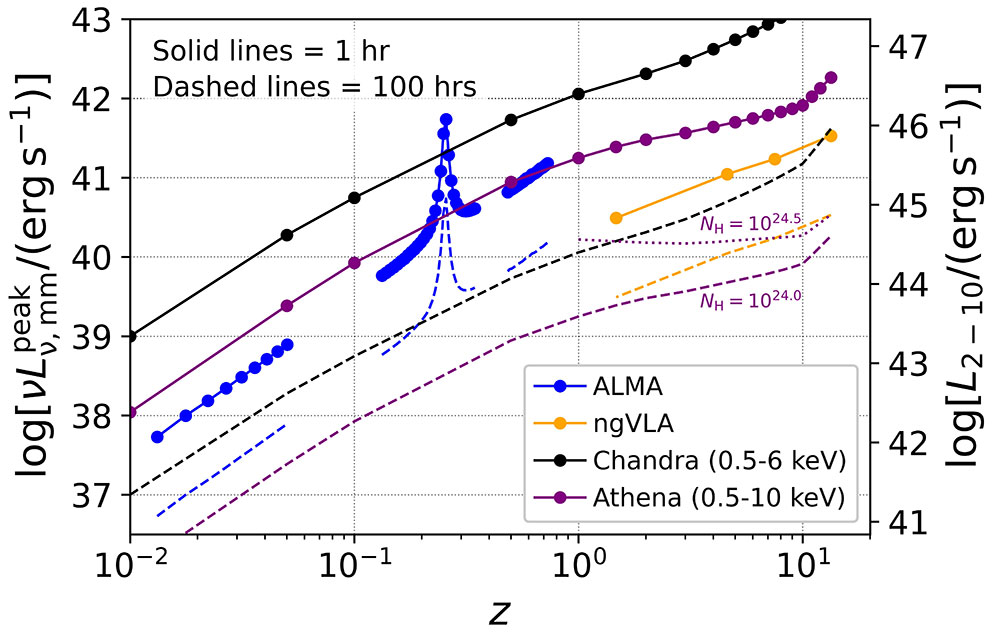
Detection limits for AGNs with NH = 1024 cm-2 over a range of redshifts. For z > 1 objects, short observations with the ngVLA are superior to Athena. For long observations the two facilities are comparable. However, Athena could miss AGNs with NH > 1024 cm-2.
[click to enlarge]
The growth history of supermassive black holes (SMBHs) is a very hot topic, and for its understanding, a census of active galactic nuclei (AGNs), i.e., the growth phase of SMBHs, is fundamental. But rapidly growing SMBHs may be covered by thick layers of gas and dust. To avoid missing this crucial growth period, observations at wavelengths with high penetrating power, such as those in the hard X-ray band, have often been used. But even in that band, heavily obscured systems with column densities NH above the Compton-thick level of 1024 cm-2 can still be easily missed.
In Kawamuro et al. (2022), we found that observations at millimeter wavelengths with high spatial resolution (≲ 100 pc) may be useful to detect even the most obscured AGN. We analyzed ALMA Band 6 data with sub-arcsec resolution for 98 hard-X-ray-selected AGNs at z < 0.05. We found a significant and tight correlation between the nuclear mm emission and the hard X-ray emission. This indicates that millimeter observations at resolutions of ≲ 100 pc can be used to detect AGNs and measure their intrinsic luminosities up to NH ~ 1026 cm-2, much higher than the Compton-thick limit of hard X-ray telescopes.
Our findings suggest that the next generation Very Large Array (ngVLA) has a strong potential for an unbiased search of high-z obscured AGNs: its frequency coverage will sample rest-frame millimeter emission from AGNs at z > 1, while its spatial resolution will probe scales ≲ 100 pc. To better understand this potential, we simulated observations of Compton-thick AGNs with column densities of 1024 cm-2 with ALMA, ngVLA, Chandra, and Athena. We then calculated the AGN luminosities detectable over a range of redshifts (see figure). The result indicates that for observations of one hour, the ngVLA can detect z > 1 objects up to an order of magnitude fainter than Athena. For observations of 100 hours, those two facilities are comparable at the Compton-thick level. But the ngVLA is expected to detect the more heavily obscured AGNs that Athena may miss. Thus, the ngVLA will be an important observatory to identify obscured AGNs at z > 1.
Since 2015 the acronym ngVLA has appeared in 850+ publications indexed in the SAO/NASA Astrophysics Data System. This article continues a regular feature intended to showcase some of those publications. We are especially interested in showcasing work done by early-career researchers. The collection of showcase articles can be viewed online. Anyone wishing to volunteer to author a feature should contact Joan Wrobel.
New CASA-integrated Pipeline Version Released for VLA Data Processing
The CASA and NRAO pipeline teams have released a new version of the VLA calibration and imaging pipeline (2022.2.0.64), running on CASA 6.4.1. This version is now installed on NRAO systems and can be downloaded by users. This version of CASA and the pipeline are identical to what is used to calibrate and image ALMA data, requiring users to install only one new version of CASA to have pipelines that are validated for both telescopes. Data processing with the new pipeline began at the start of the VLA C-configuration, during the first week of October 2022.
The primary new features of the pipeline that are specific for the VLA are:
- A major bug affecting the flux density scale of VLA multi-band data where the flux density fit for the complex gain calibrator used a fit order >2 has been fixed. A detailed description.
- Gain compression correction is available via the hifv_syspower task for L, S, C, X, and Ku bands; this is to address the receiver gain compression induced by very strong RFI. The gain compression correction is not applied by default, but can be applied if necessary after diagnostic plots are reviewed.
- The long gain solution interval calculation was re-factored which will prevent extremely long solution intervals from negatively affecting calibration.
- The hifv_targetflag task is removed from the default recipe and its RFI flagging heuristics have been integrated into hifv_checkflag(checkflagmode='target-vla') (the last call to hifv_checkflag in the pipeline).
- The hifv_statwt weblog now provides plots and statistics per antenna, scan, and spw to enable identification of discrepant weights (particularly very high weights).
- The plots in hifv_plotsummary now show only one calibrator per plot and are shown in frequency order.
- Plots of total electron content (TEC) are now available in hifv_priorcals (the correction is not applied by default). Note that TEC data are only available for data processed a few days after observations were taken.
- Intent filtering for hifv_fluxboot has been adjusted to better allow/omit sources from the flux density bootstrapping and should prevent failures of flux density scale calibration for some setups.
- The task hifv_applycals will now backup flags by default, better enabling the use of the Polarization CASA guide.
- A new task hifv_flagtargetsdata has been added for use in the VLA imaging pipeline as a lightweight task for applying additional flags.
QA warnings in tasks will be collected and condensed into an expandable view. This will prevent a number of messages repeated for multiple antennas and spectral windows from filling the weblog page.
See also the ALMA pipeline documentation for general, non-VLA specific infrastructure changes, a more detailed description of the VLA Calibration pipeline, and a description of the VLA Imaging pipeline.
CASA Reference Papers Published

CASA, the Common Astronomy Software Applications, is the primary data-processing software for ALMA and the Karl G. Jansky VLA, and is frequently used also for other radio telescopes. The CASA software can handle data from single-dish, aperture-synthesis, and Very Long Baseline Interferometery (VLBI) telescopes, and one of its core functionalities is support of the calibration and imaging pipelines for ALMA and the VLA.
To offer the community reference materials for the CASA software, two new CASA papers are now available on astro-ph. These papers will simultaneously appear for publication in an upcoming issue of Publications of the Astronomical Society of the Pacific (PASP).
CASA reference paper:
The CASA Team et al., CASA, the Common Astronomy Software Applications for Radio Astronomy, arXiv:2210.02276, DOI: 10.1088/1538-3873/ac9642
This CASA paper allows users to familiarize themselves with the principles and philosophy behind CASA. It presents a high-level overview of the basic structure of the CASA software, as well as procedures for calibrating and imaging astronomical radio data in CASA. This paper is the new CASA reference paper, aimed at the general user community.
CASA-VLBI paper:
I.M. van Bemmel, M. Kettenis, D. Small, et al., CASA on the fringe -- Development of VLBI processing capabilities for CASA, arXiv:2210.02275, DOI: 10.1088/1538-3873/ac81ed
This paper describes new tasks and functionalities implemented in CASA for the processing of Very Long Baseline Interferometry (VLBI) data. This work was led by the Joint Institute for VLBI European Research Infrastructure Consortium (JIVE) in collaboration with the CASA team. See the JIVE News article for details.
Please use these new papers as citations for the CASA software package or VLBI-specific CASA implementations within articles that use these resources.
CASA is being developed by an international consortium of around 40 scientists and software engineers based at the National Radio Astronomical Observatory (NRAO), the European Southern Observatory (ESO), the National Astronomical Observatory of Japan (NAOJ), and the Joint Institute for VLBI European Research Infrastructure Consortium (JIV-ERIC), under the guidance of NRAO. For more information, see the CASA website.
ALMA Program News
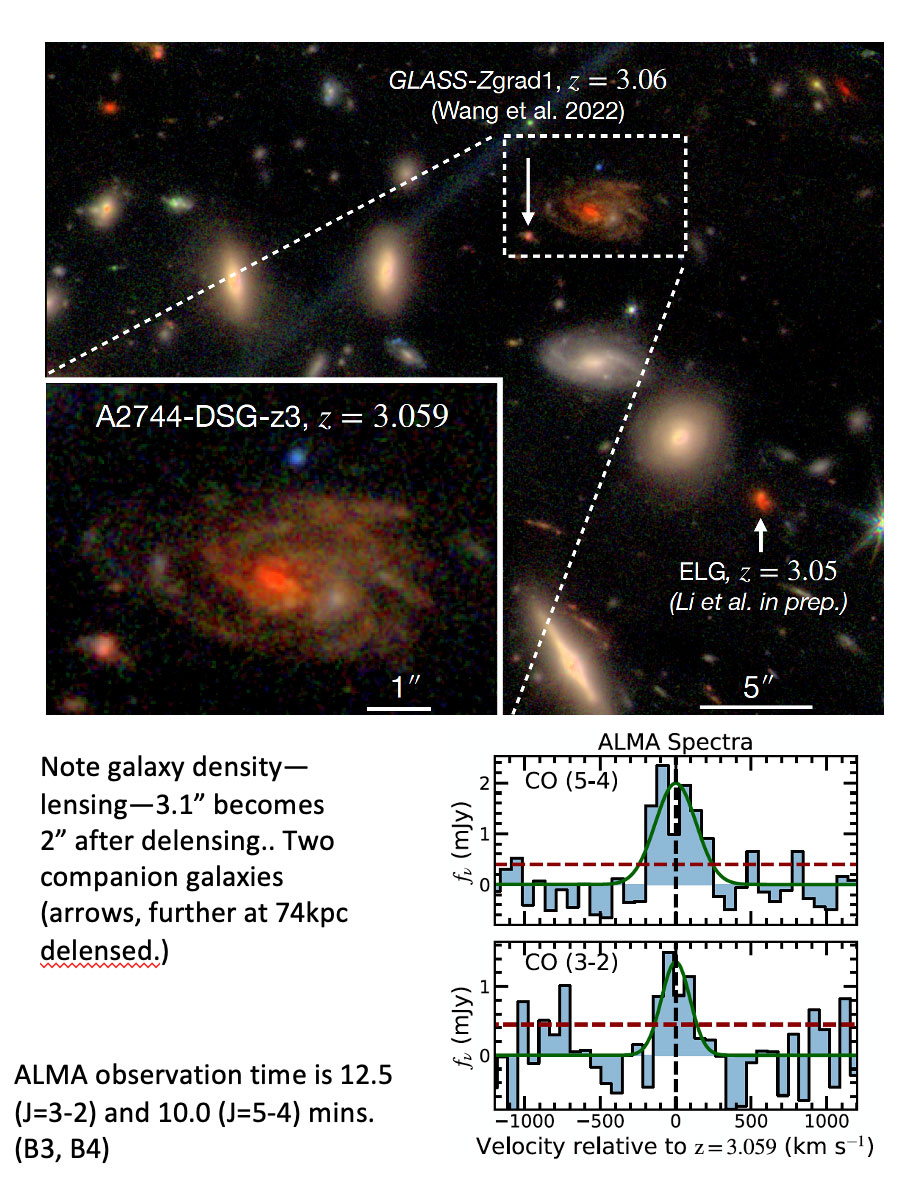
[click to enlarge]
ALMA Status: Cycle 9 Begins
As Spring comes to the 5000m high ALMA site just north of the Tropic of Capricorn, daily high temperatures begin to creep above freezing. ALMA is in compact configurations, beginning with C-3, through the end of the year. Cycle 9 data acquisition began 30 September 2022. Cycle 8 2021 saw the second highest amount of successful observing time on the 12-m Array in ALMA history; successful observing time on the Morita Array exceeded that of Cycle 7.
AAS Special Session 141: ALMA Status and Plans for Increased Capability, including the Wideband Sensitivity Upgrade
A Special Session titled ALMA Status and Plans for Increased Capability has been scheduled for the 8-12 January 2023, 141st meeting of the American Astronomical Society (AAS) meeting in Seattle, Washington (Monday, 9 January 2023, 2:00 - 3:30 pm PST, Ballroom 6A).
This Session will describe for the membership ALMA news, capabilities, and expectations for ALMA performance and science in the next few years, and plans for its upgrade in the timeframe of this decade. In that period, The ambitious “ALMA2030 Wideband Sensitivity Upgrade,” seeks to at least double and eventually quadruple the correlated bandwidth of the ALMA Observatory’s antennas. The 1.3mm band receiver (Band 6v2) will be the first receiver upgraded as a part of the ALMA2030 Development Roadmap. ALMA/NA Program Scientist Brogan noted that the receiver was chosen for the first upgrade because “Band 6 is currently ALMA’s most popular band in terms of the number of hours proposed each cycle. We see more ALMA publications reporting results from this band than any other in every observing year.” As of this writing, over 1600 of ALMA's 2925 published papers used the 1.3mm band.
New frequency windows (bands) are coming. Preliminary acceptance on ALMA Band 1 receivers covering 35-50GHz is scheduled to complete this month; science verification will occur in December for the planned Cycle 10 (late 2023) offering. Prototype Band 2 (67-116 GHz) cold cartridge assemblies have been tested in the ALMA cryostat at the NRAO Central Development Laboratory. With these bands, ALMA will complete its frequency coverage of the millimeter window. ALMA's bandwidth will be increased to enhance continuum sensitivity even as its line sensitivity is increased via receiver upgrades, an upgraded correlator and upgrades of the systems connecting them. Higher resolution imaging is being explored, both on the exceptional site and as part of the extremely long baseline imaging arrays. The Special Session will feature science talks presenting a wide range of recent, exciting ALMA results and will highlight the support available to the community from the North American ALMA Science Center at the NRAO.
ALMA at 10-years: Past, Present, and Future Conference
To commemorate its first decade of science operations, the ALMA partnership is organizing a conference in Puerto Varas, Chile on 4-8 December 2023 that will take a look back at the Observatory’s accomplishments, highlight its latest results, and look forward to future technical developments. The first decade of ALMA has led to many exciting discoveries and over 2900 publications. As ALMA starts its second decade of operations, it is implementing the Wideband Sensitivity Upgrade, an ambitious development roadmap that will ultimately quadruple the system bandwidth and vastly improve ALMA's observing efficiency for continuum and spectral line science.
This conference will include invited and contributed talks, and poster presentations. A hybrid format will allow participants to choose to attend in-person or remotely on a virtual platform. Talks and posters are welcome in all fields of astronomy, from cosmology and galaxies in the distant Universe to nearby galaxies and the Galactic Center, interstellar medium, and star formation in our Galaxy, as well as astrochemistry, circumstellar disks, exoplanets, Solar System, stellar evolution, and the Sun.
More information on the conference will be posted on the conference website as it becomes available. Registration will open in early 2023.
NAASC support for conferences and workshops
The North American ALMA Science Center (NAASC) is accepting applications for funding support of conferences and workshops. Check out our website for more information! For proposals requesting more than $10,000, the deadline to submit an application has been extended to 21 November 2022. For other proposals, we will accept applications while funds last.
The ALMA Archive v1.0
Science archives are cornerstones of modern astronomical facilities. A recent paper (The Messenger, vol. 187, p. 25-30) describes the version 1.0 milestone of the Atacama Large Millimeter/submillimeter Array Science Archive. This version features a comprehensive query interface with rich metadata and visualization of the spatial and spectral locations of the observations, a complete set of virtual observatory services for programmatic access, text-based similarity search, display and query for types of astronomical objects in SIMBAD and NED, browser-based remote visualizsation, interactive previews with tentative line identification and extensive documentation including video and Jupyter Notebook tutorials. The development is regularly evaluated by means of user surveys and is entirely focused on providing the best possible user experience with the goal of helping to maximise the scientific productivity of the observatory.
The NURF Survey
A lengthy but crucial process that underpins much of astronomical research is the characterization and monitoring of reference sources. Knowledge of a source’s characteristics (position, brightness, spectral features, etc.) with good precision usually comes courtesy of dedicated efforts to observe a large number of reference and calibration targets across the sky, and across the energy spectrum. This often requires large amounts of precious telescope time.
A new joint project of the NRAO and the U.S. Naval Observatory is underway to monitor important calibration sources, which will aid in future scientific and operational efforts, and will benefit the entire radio community. The best part is that it is piggy-backing on existing observations, without requiring “extra” time on the telescope. This project is called the NRAO/USNO Reference and Flux-density survey, or NURF for short.
Several ongoing series of regular short geodetic observations with the Very Long Baseline Array only require a few of the outermost stations in the array. Capitalizing on the great flexibility of the instrument to enable sub-array observations, the otherwise-idle inner stations are being used during this time to survey thousands of other objects of interest. These primarily include sources that may be suitable for phase referencing, but some may prove useful for flux calibration. Additionally, it is targeting various important targets in the International Celestial Reference Frame (ICRF).
Currently, NURF observations are mostly optimized as short snapshots to determine suitability as reference targets in the K-band (21.7–24.1 GHz). A reliable list of known and monitored phase reference targets across the sky is much needed in this band at the ultra-fine resolutions of Very Long Baseline Interferometry arrays, especially as radio observations push to higher frequencies.
While still undergoing development, the whole process from scheduling observations through data reduction in NURF will be mostly automated, and flexible enough to observe new source lists or with new setups as the need arises. Little by little, we are building up a wealth of reference observations which will help improve many future studies. The future is bright, especially in K-band!
Robert L Brown Outstanding Doctoral Dissertation Award
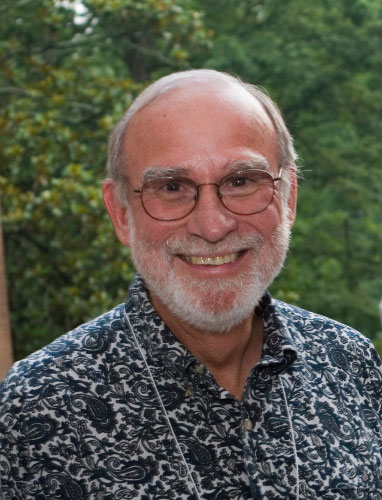
The Robert L. Brown Outstanding Doctoral Dissertation Award is administered by Associated Universities, Inc. (AUI) and the NRAO on behalf of Bob Brown’s friends and family to honor Bob’s life and career. The Award is given each year to a recent recipient of a doctoral degree from any recognized degree granting institution in the United States, and is substantially based on new observational data obtained at any AUI operated facility and considered to be of an exceptionally high scientific standard value and impact within and beyond the area of study.
Award
The Award is available to degree recipients of any nationality and consists of $1000, a framed certificate, and an invitation to give a lecture at the NRAO.
Application Guidelines
To be eligible, the applicant must have successfully defended the thesis during the calendar year of the Award.
The deadline for receipt of applications and supporting materials for the 2022 Award is December 31, 2022.
Applicants should send an e-mail describing their dissertation, the date of their successful thesis defense, the date of the degree award, and the name and contact information of the primary thesis supervisor to RLBrownAward@nrao.edu. A copy of the thesis as a pdf file should be sent by e-mail to the same address or made available via a link given in the email. Published papers or papers in press, or portions thereof, based substantially on the dissertation should accompany the application. Verification of the successful thesis defense and statement that the applicant has successfully completed all university requirements for the Ph.D. should be sent directly by the appropriate university authority to RLBrownAward@nrao.edu.
Selection
The winning applicant will be selected by a committee appointed by the NRAO Director. If, in the opinion of the committee, in any given year none of the theses are sufficiently meritorious, the award will not be given in that year.
All questions should be addressed to RLBrownAward@nrao.edu.
Cycle 11 Call for Proposals: LWA Radio Observatory
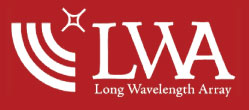
We invite applications for observing time with the LWA Radio Observatory. The complete call for proposals including the required cover page can be found at http://lwa.unm.edu. At this time proposers can request observations with LWA1, LWA-SV, or an interferometry mode between the two.
LWA1 currently offers up to three independently-steerable wide-band beams. Each beam supports two independent tunings over the LWA1 frequency range from 10 to 88 MHz with a FWHM ranging from 15 to 2 degrees. Each tuning can cover up to 20 MHz bandwidth. Two all-dipole modes are also available; a transient buffer narrow (TBN), and a transient buffer wide (TBW).
LWA-SV offers up to two beams with 2 tunings of 20 MHz each. The two tunings are dependent between the beams, and thus need to be at the same frequency. In addition, two all-dipole modes are available; a transient buffer narrow (TBN) and a transient buffer frequency domain (TBF).
For the interferometer mode two beams are used at both LWA1 and LWA-SV, one-beam for calibration and the other beam for the target source. The correlation produces a fan-beam on the sky with a phase center that is affected by the ionosphere. The bandwidth available is 2 tunings of 20 MHz each. For details about the observing setup and data reduction see the online tutorial at: http://www.phys.unm.edu/~lwa/singleB_tutorial.pdf
The deadline for application is 11:59 pm MDT on November 1, 2022 and covers observations expected to occur in the 2023 calendar year. The complete call for proposals including the required and updated cover page can be found at http://lwa.unm.edu. Support for operations and continuing development of the LWA is provided by the National Science Foundation under grant AST-1835400 of the MSIP program, and the Air Force Research Laboratory. We invite proposals from all communities wishing to use this instrument.
More information about the capabilities of the LWA1 can be found on the LWA web pages http://www.phys.unm.edu/~lwa/status.html. An introduction to using the LWA1 is also available at http://www.ece.vt.edu/swe/lwa1/.
For questions regarding this call for proposals, please email lwa@unm.edu.
Recent Media Releases
|
VLA Finds Cosmic Rays Driving Galaxy's Winds |
|
|
NRAO's Marion Pospieszalski Receives EuMA Pioneer Award |
|
|
NRAO Expands Radio Dynamic Zone Testing with Support from NSF |
From the Archives
Ellen Bouton

[click to enlarge]
About this month's photo: In October 2005, the NRAO Education and Public Outreach team organized a public open house at the Edgemont Road facilities in Charlottesville that featured a broad array of informational and hands-on displays, children's activities, equipment samples, etc. Many staff members participated and were available throughout the afternoon to demonstrate, explain, and answer questions, including these three wizards. Left to right: Scott Ransom, Paul Vanden Bout, and Rob Reid.
From the Archives is an ongoing series illustrating NRAO and U.S. radio astronomy history via images selected from our collections of individuals' and institutional papers. If readers have images they believe would be of interest to the Archives, please contact Ellen Bouton.

